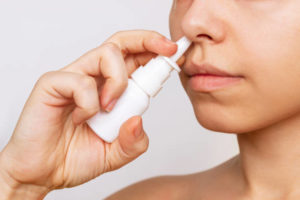
A nasal spray may not be the most common medication dosage form. However, for certain people, especially those who frequently experience stuffy noses or allergy symptoms, this device is highly beneficial. The nasal spray contains active ingredients that readily permeate the blood vessels on the inner surface of the nose.
In certain circumstances, a nasal spray is preferable to oral medication because its active ingredients are absorbed more quickly. This rapid absorption enables faster relief from discomfort. Therefore, proper use should be emphasized so that the absorption of the active ingredient can be optimized and the desired effect achieved.
Uses of nasal sprays
Nasal sprays are typically used for a number of conditions, most of which are dependent on the device’s main active ingredient. Before using a nasal spray, consumers should consult a doctor or pharmacist to ensure that the right nasal spray is used to treat the problem. There are three primary applications for nasal spray:
As a decongestant for a stuffy nose
Among the active ingredients used in decongestant nasal sprays are oxymetazoline and phenylephrine. These active ingredients alleviate the unpleasant feeling of congestion by constricting blood vessels and thus decreasing the size of swollen nasal tissue. If the user needs fast relief, a decongestant nasal spray is an appropriate option, particularly when the user has a severe illness or allergy.
However, the decongestant nasal sprays should not be used for longer than three days. Long-term use raises the likelihood that users will develop a harmful dependence on the active ingredient. This situation could lead to a rebound effect, in which symptoms return after the treatment is completed.
Reduce inflammation due to allergic reactions
Inflammation symptoms such as swelling on the inside of the nose, excessive mucus secretion, and frequent sneezing can be treated with a nasal spray containing steroid-based active ingredients. This nasal spray is therefore suitable for treating rhinitis, sinusitis, and nasal polyps. Budesonide, fluticasone, mometasone, and triamcinolone are a few examples of medications in this class.
In general, this nasal spray does not cause severe side effects when used properly and in the recommended dosage. However, caution should be exercised when using a nasal spray containing steroids. Users should always be aware of the symptoms of adverse effects, such as a nasal sore, dry mouth and throat, and nosebleeds.
- Dilutes mucus in the nose
A nasal spray containing saline serves to soften and prevent the hardening of mucus. This function can assist the user in maintaining nasal moisture. In addition, saline, as an active ingredient, can aid in the removal of debris from the interior of the nostrils. However, this form of nasal spray device cannot be used to treat nasal congestion.
- Systemic effects in certain conditions
Other than treating nasal conditions, nasal sprays could also be used for other systemic conditions, such as diabetes insipidus, for which desmopressin nasal spray is one of the treatments. Acute nose bleeds could be mitigated by using a nasal spray containing a combination of lignocaine and phenylephrine. The same nasal spray could also be used as a topical anesthetic before medical procedures.

Techniques for the use of nasal sprays
- First-time use (priming):
First, remove the protective cover from the nasal spray. The correct technique to hold the device is to grip the top of the nasal spray device with the index and middle fingers while supporting the base with the thumb. Then, shake the spray to ensure that the contents are thoroughly combined and homogeneous. There is, however, a nasal spray that should not be shaken. Therefore, consumers ought to seek advice from a doctor or pharmacist to check on this matter.
Press the nasal spray device until the contents are visible in the air. Depending on the device, the applicator may need to be pressed three to ten times during this procedure. This process is referred to as priming. Priming is only performed once per nasal spray. However, if the spray has not been used for more than one to two weeks, priming has to be repeated.
- Subsequent uses:
Each time before using a nasal spray, the user must remove mucus from the nostril or clean the nose. When ready, the user should slightly bow the head forward before carefully putting the tip of the nasal spray into the nostrils. A nasal spray should be inserted a quarter or half an inch into the nostril, depending on the device used. At the same time, the other nostrils should be covered with fingers.
Then, press the nasal spray once while gently inhaling air through the nose. Avoid spraying the contents of the nasal spray directly on the nasal wall. Repeat the same steps to administer the next dose to the opposite nostril.
Users are recommended not to lift their heads while using a nasal spray in order to prevent the contents of the device from entering the throat. If the medication is swallowed, it will give a bitter taste. Consumers should not be worried because this is a common occurrence and the amount of medication that reaches the throat is very minimal.
After using a nasal spray, wipe the tip of the device with a tissue or cloth and reattach the protective cap. After using a nasal spray, the user should not forcefully exhale through the nose or cleanse the nostrils.
Advice to consumers and the public
A nasal spray device is a beneficial device, but it must be used properly for optimal results. Users are encouraged to seek the advice and opinion of a doctor or pharmacist so as to determine which type of nasal spray is appropriate for the illness. In addition, if the health issue persists despite using a nasal spray, users are advised to seek further examination.
If there are any inquiries regarding medicines, please call the National Pharmacy Call Centre (NPCC) at the toll-free number 1-800-88-6722 during weekdays from 8 a.m. to 5 p.m., except on public holidays.
References:
- Garis Panduan Kaunseling Ubat-ubatan Edisi ke-3
- www.myhealth.com
- www.hellodoktor.comhttps://www.drugs.com/cdi/nasal-decongestant-spray.html
- https://www.webmd.com/allergies/decongestants
- https://www.nhs.uk/conditions/steroid-nasal-sprays/
- https://www.webmd.com/allergies/saline-spray
Prepared by:
Siti Sarah Syahirah Binti Kushairi
Pharmacist
Hospital Raja Perempuan Zainab II Kota Bharu
